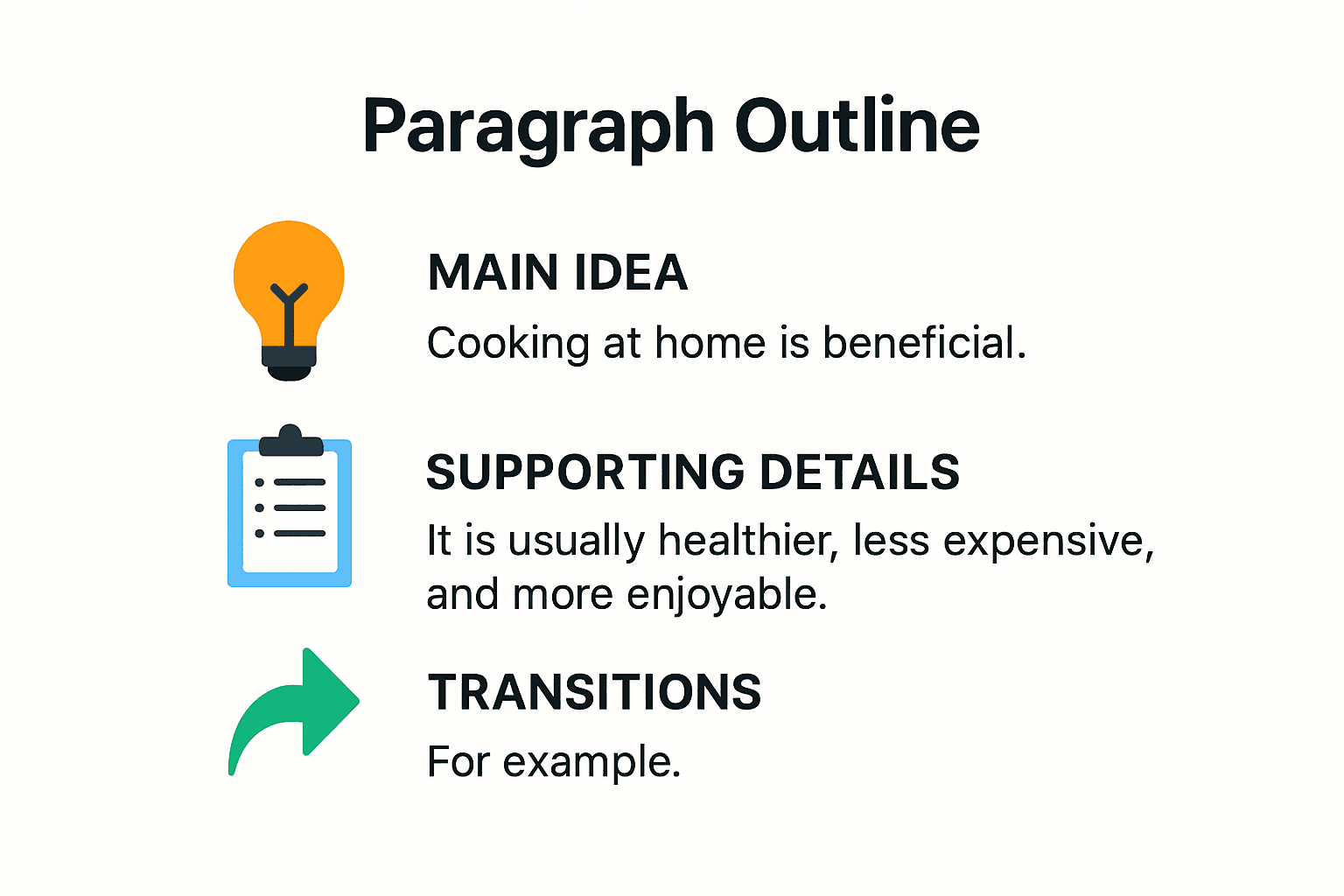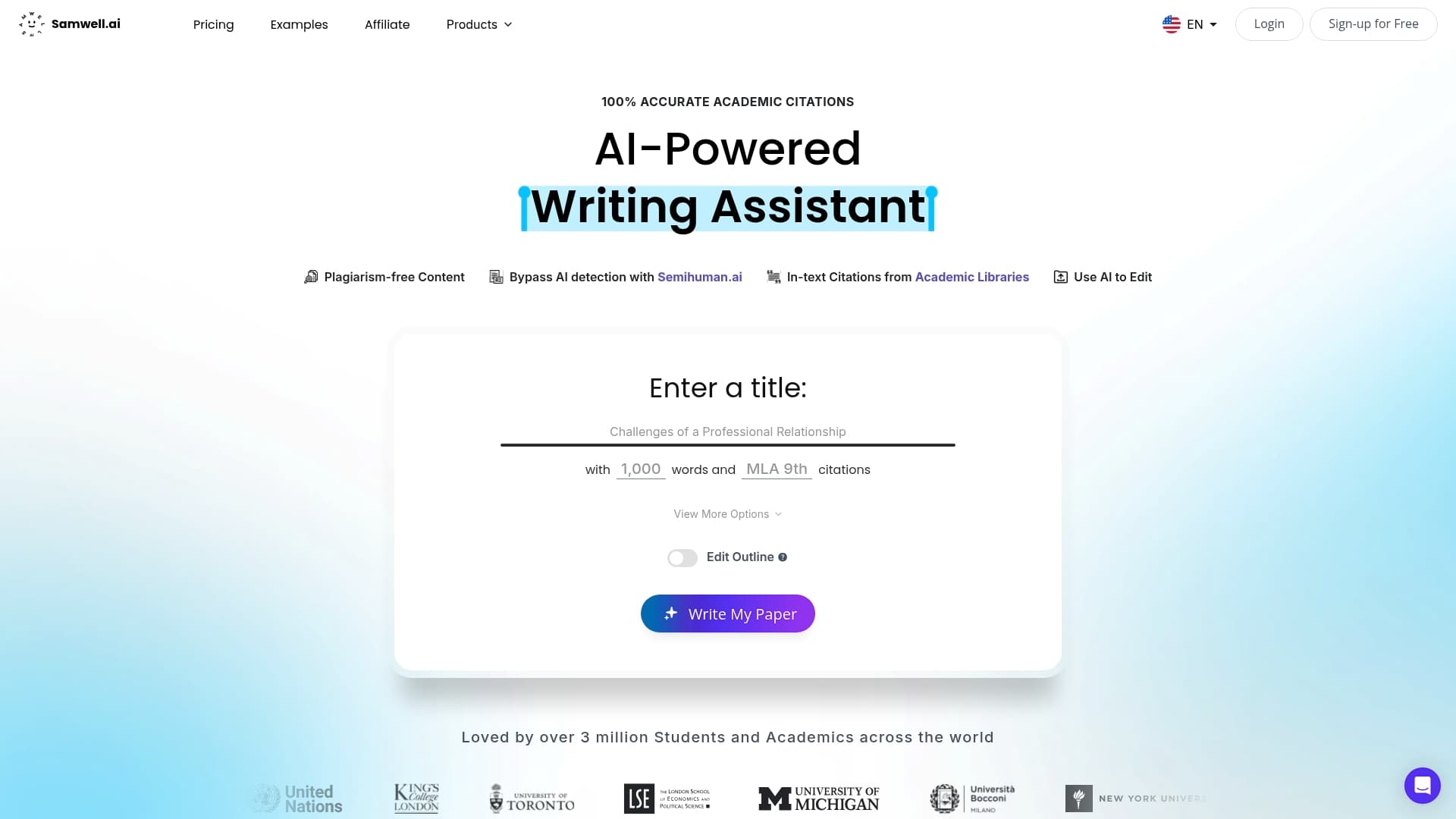Blog
Learning Materials
Paragraph Outline Sample: Effective Guide for 2025
Updated: July 10, 2025

Writers often struggle to turn a jumble of ideas into clear, powerful paragraphs. Now here’s something most people skip. A well-structured paragraph outline can cut writing time by up to 30 percent and boost coherence across an entire piece. Outlines are not just academic busywork—they are your secret weapon for tighter arguments, better organization, and writing that stands out every single time.
Table of Contents
- What Is A Paragraph Outline Sample? Dockerfile README.md email-templates i18n-config.ts i18nConfig.ts next-sitemap-samwell.config.js next-sitemap-semihuman.config.js next.config.js node_modules package-lock.json package.json process_content.js public scripts src svgr.d.ts translations tsconfig.json Understanding The Basic Structure Dockerfile README.md email-templates i18n-config.ts i18nConfig.ts next-sitemap-samwell.config.js next-sitemap-semihuman.config.js next.config.js node_modules package-lock.json package.json process_content.js public scripts src svgr.d.ts translations tsconfig.json Critical Components Of An Effective Paragraph Outline
- Step-By-Step Guide To Creating Outlines Dockerfile README.md email-templates i18n-config.ts i18nConfig.ts next-sitemap-samwell.config.js next-sitemap-semihuman.config.js next.config.js node_modules package-lock.json package.json process_content.js public scripts src svgr.d.ts translations tsconfig.json Initial Planning And Brainstorming Dockerfile README.md email-templates i18n-config.ts i18nConfig.ts next-sitemap-samwell.config.js next-sitemap-semihuman.config.js next.config.js node_modules package-lock.json package.json process_content.js public scripts src svgr.d.ts translations tsconfig.json Structuring Your Outline Dockerfile README.md email-templates i18n-config.ts i18nConfig.ts next-sitemap-samwell.config.js next-sitemap-semihuman.config.js next.config.js node_modules package-lock.json package.json process_content.js public scripts src svgr.d.ts translations tsconfig.json Refining And Finalizing The Outline
- Examples And Templates For Students And Educators Dockerfile README.md email-templates i18n-config.ts i18nConfig.ts next-sitemap-samwell.config.js next-sitemap-semihuman.config.js next.config.js node_modules package-lock.json package.json process_content.js public scripts src svgr.d.ts translations tsconfig.json Academic Writing Paragraph Outline Templates Dockerfile README.md email-templates i18n-config.ts i18nConfig.ts next-sitemap-samwell.config.js next-sitemap-semihuman.config.js next.config.js node_modules package-lock.json package.json process_content.js public scripts src svgr.d.ts translations tsconfig.json Graphic Organizers And Visual Templates Dockerfile README.md email-templates i18n-config.ts i18nConfig.ts next-sitemap-samwell.config.js next-sitemap-semihuman.config.js next.config.js node_modules package-lock.json package.json process_content.js public scripts src svgr.d.ts translations tsconfig.json Specialized Paragraph Outline Approaches
- Best Practices For Academic Writing Organization Dockerfile README.md email-templates i18n-config.ts i18nConfig.ts next-sitemap-samwell.config.js next-sitemap-semihuman.config.js next.config.js node_modules package-lock.json package.json process_content.js public scripts src svgr.d.ts translations tsconfig.json Structural Integrity In Academic Writing Dockerfile README.md email-templates i18n-config.ts i18nConfig.ts next-sitemap-samwell.config.js next-sitemap-semihuman.config.js next.config.js node_modules package-lock.json package.json process_content.js public scripts src svgr.d.ts translations tsconfig.json Discipline-Specific Writing Frameworks Dockerfile README.md email-templates i18n-config.ts i18nConfig.ts next-sitemap-samwell.config.js next-sitemap-semihuman.config.js next.config.js node_modules package-lock.json package.json process_content.js public scripts src svgr.d.ts translations tsconfig.json Effective Communication Strategies
Quick Summary
| Takeaway | Explanation |
|---|---|
| Effective Paragraph Outlines are Essential | A paragraph outline sample helps writers organize thoughts and structure arguments, ensuring each paragraph contributes meaningfully to the overall narrative. |
| Structured Approach Improves Writing | Following a systematic framework, like an alphanumeric outline, allows for clear hierarchical organization, making complex writing tasks more manageable. |
| Initial Planning is Crucial | Comprehensive brainstorming and research during the planning phase help identify key ideas and directions for writing, enhancing overall coherence. |
| Templates and Visual Aids Enhance Clarity | Utilizing paragraph outline templates and graphic organizers assists students and educators in visualizing connections between ideas, improving structured writing. |
| Adaptability is Key | A well-constructed outline should remain flexible, allowing for adjustments during the writing process, ensuring that document quality is maintained. |
What Is a Paragraph Outline Sample?
A paragraph outline sample represents a strategic planning tool that helps writers organize their thoughts, structure their arguments, and create a clear roadmap for academic or professional writing. At its core, this document provides a systematic approach to breaking down complex ideas into manageable, logical segments.
Understanding the Basic Structure
A paragraph outline sample typically functions as a blueprint for writing, mapping out the essential components of each paragraph before actual composition begins. Learn more about creating effective writing structures to enhance your academic writing skills. Writers use this tool to ensure that each paragraph contributes meaningfully to the overall argument, maintaining a coherent and focused narrative.
The traditional paragraph outline incorporates several key elements:
- Main Idea: A clear, concise statement representing the central concept of the paragraph
- Supporting Details: Specific evidence, examples, or explanations that substantiate the main idea
- Transitional Elements: Connections that link the current paragraph to subsequent or preceding sections
According to academic writing experts at Walden University, effective paragraph outlines typically follow two primary formats: topic outlines and sentence outlines. Topic outlines use brief phrases to represent key points, while sentence outlines employ complete sentences to detail each conceptual element.

Critical Components of an Effective Paragraph Outline
Creating a robust paragraph outline sample requires careful consideration of several critical components. Research from Excelsior College suggests using an alphanumeric format that hierarchically represents the relationship between different levels of ideas.
The most successful paragraph outlines demonstrate:
- Logical Progression: A clear, sequential flow of ideas that builds coherent arguments
- Precision: Specific and focused statements that avoid unnecessary complexity
- Flexibility: Room for adaptation and refinement during the writing process
Professional writers and academic researchers recognize that a well-constructed paragraph outline sample serves multiple purposes. It acts not just as a planning document, but as a diagnostic tool that helps identify potential weaknesses in argumentation before extensive writing begins. By mapping out ideas in advance, writers can ensure each paragraph contributes substantively to the overall narrative, maintaining intellectual rigor and clarity.
Whether you are crafting a research paper, developing an academic essay, or preparing a professional report, mastering the art of creating a paragraph outline sample represents a fundamental skill that can dramatically improve the quality and effectiveness of your written communication.
Step-by-Step Guide to Creating Outlines
Creating an effective outline transforms complex writing tasks into manageable processes. This systematic approach provides writers with a strategic framework to organize thoughts, develop arguments, and ensure logical progression of ideas. Explore our comprehensive essay outline strategies to elevate your writing technique.
Initial Planning and Brainstorming
The first crucial step in creating an outline involves comprehensive brainstorming and preliminary research. According to academic writing experts at K12 Tutoring, preparing an outline before writing helps writers identify potential research gaps and organize thoughts effectively.
Begin by generating a list of key ideas and potential arguments. This process involves:
- Concept Mapping: Create visual representations of interconnected ideas
- Research Collection: Gather preliminary sources and supporting evidence
- Thesis Development: Formulate a clear central argument
Structuring Your Outline
Research from the Atlas Organization suggests implementing a standardized outline format that provides clear hierarchical structure. The traditional alphanumeric outline method offers a systematic approach:
- Roman numerals (I, II, III) represent main topics
- Capital letters (A, B, C) indicate primary supporting points
- Arabic numerals (1, 2, 3) provide additional detailed explanations
For instance, a typical academic essay outline might look like:
I. Introduction A. Hook statement B. Background information C. Thesis statement
II. First Main Argument A. Supporting evidence B. Analytical explanation C. Counterargument consideration
III. Second Main Argument A. Supporting evidence B. Analytical explanation C. Potential implications
Refining and Finalizing the Outline
According to academic writing guidance from Sophia Learning, the final stage involves critical review and refinement. Successful outlines demonstrate flexibility while maintaining structural integrity. Writers should:
- Review Logical Flow: Ensure smooth transitions between sections
- Check Supporting Evidence: Verify each point has substantial backup
- Eliminate Redundancies: Remove repetitive or unnecessary information
Professional writers understand that an outline is not a rigid document but a dynamic planning tool. It should provide guidance while remaining adaptable to emerging insights during the writing process. By meticulously crafting an outline, writers can significantly reduce writing time, minimize potential structural issues, and produce more cohesive and compelling documents.
Mastering the art of creating comprehensive outlines represents a fundamental skill for academic success, professional communication, and effective written expression.

Examples and Templates for Students and Educators
Effective paragraph outline samples serve as critical tools for students and educators, providing structured frameworks that transform complex writing challenges into manageable tasks. Discover advanced outlining strategies to enhance academic writing precision and clarity.
Academic Writing Paragraph Outline Templates
The Writing Revolution highlights the importance of structured paragraph outlines in academic writing. Educators and students can leverage multiple template formats to suit different writing objectives:
-
Five-Paragraph Essay Outline: I. Introduction A. Hook statement B. Background context C. Thesis statement II. First Body Paragraph A. Topic sentence B. Supporting evidence C. Analysis III. Second Body Paragraph A. Topic sentence B. Supporting evidence C. Analysis IV. Third Body Paragraph A. Topic sentence B. Supporting evidence C. Analysis V. Conclusion A. Restate thesis B. Summarize main points C. Closing reflection
-
Research Paper Outline: I. Title Page II. Abstract III. Introduction A. Research question B. Hypothesis C. Significance of study IV. Methodology V. Results VI. Discussion VII. Conclusion
Graphic Organizers and Visual Templates
TeacherVision recommends utilizing graphic organizers as powerful visual tools for developing paragraph outlines. These templates help students visualize connections between ideas and create more structured writing.
Key visual outline techniques include:
- Mind Mapping: Create radial diagrams connecting central ideas with supporting concepts
- Concept Webs: Illustrate relationships between different argumentative elements
- Hierarchical Diagrams: Demonstrate progressive idea development
Below is a summary table comparing different visual outlining techniques and their features to clarify their uses for students and educators.
| Visual Organizer | Description | Best for |
|---|---|---|
| Mind Mapping | Radial diagrams linking a central theme to related ideas | Brainstorming concepts |
| Concept Webs | Networks showing relationships between multiple ideas | Exploring connections |
| Hierarchical Diagram | Tiered structure showing order and progression of information | Organizing complex topics |
Specialized Paragraph Outline Approaches
Walden University's Writing Center emphasizes adaptable outlining strategies that cater to diverse writing requirements. Different academic disciplines and writing styles demand unique approaches:
- Humanities Outline: Emphasizes narrative flow and critical analysis
- Scientific Outline: Prioritizes methodical presentation of empirical evidence
- Comparative Analysis Outline: Structures arguments through systematic comparison
Professional educators recognize that no single outline template fits all writing scenarios. The most effective paragraph outline samples remain flexible, allowing writers to adapt structures to specific academic or professional contexts. By mastering various outline formats, students develop critical thinking skills and learn to communicate complex ideas with precision and clarity.
Ultimately, paragraph outline samples are not rigid constraints but dynamic tools that empower writers to transform abstract thoughts into compelling, well-structured narratives.
Best Practices for Academic Writing Organization
Organizing academic writing requires strategic planning and a systematic approach that ensures clarity, coherence, and intellectual rigor. Explore advanced academic writing techniques to elevate your scholarly communication skills.
Structural Integrity in Academic Writing
Harvard University's Writing Center emphasizes the critical importance of logical organization in academic documents. Effective writing goes beyond mere content delivery to create a seamless intellectual journey for readers.
Key principles of structural organization include:
- Logical Progression: Develop ideas sequentially and coherently
- Clear Hierarchical Structure: Establish main arguments and supporting details
- Consistent Formatting: Maintain uniform presentation standards
Discipline-Specific Writing Frameworks
Purdue University's Online Writing Lab highlights different organizational approaches across academic disciplines. Researchers must adapt their writing structure to meet specific field requirements:
- Scientific Writing: Utilize the IMRAD structure (Introduction, Methods, Results, and Discussion)
- Humanities: Emphasize narrative flow and critical analysis
- Social Sciences: Balance empirical evidence with theoretical frameworks
To further illustrate distinct approaches, the following table summarizes common writing frameworks across core academic disciplines.
| Discipline | Organizational Approach | Key Features |
|---|---|---|
| Sciences | IMRAD (Introduction, Methods, Results, Discussion) | Structured, empirical, section-based |
| Humanities | Narrative/Analytical | Thematic development, critical analysis |
| Social Sciences | Theoretical/Empirical Mix | Balances data and theory, uses structured arguments |
Effective Communication Strategies
Harvard Library's Writing Guide recommends several communication strategies to enhance academic writing organization:
- Precision in Language: Use clear, concise terminology
- Minimize Technical Jargon: Ensure accessibility for broader academic audiences
- Strategic Paragraph Development: Create focused paragraphs with clear topic sentences
Successful academic writing requires writers to view their document as an intellectual ecosystem where each section interconnects seamlessly. The most effective organizational approaches transform complex ideas into accessible, compelling narratives.
Professional scholars understand that superior writing organization is not about rigid adherence to rules but about creating an intuitive intellectual experience. By mastering these organizational principles, writers can communicate complex concepts with remarkable clarity and persuasive power.
Ultimately, well-organized academic writing transcends mere information transmission. It becomes a sophisticated dialogue that invites readers into deeper understanding, critical reflection, and intellectual engagement.
Frequently Asked Questions
What is a paragraph outline sample?
A paragraph outline sample is a strategic planning tool that helps writers organize their thoughts, structure their arguments, and create a clear roadmap for writing.
Why are paragraph outlines important for writing?
Paragraph outlines are essential as they improve coherence, enhance organization, and help writers maintain focus, which can lead to a 30% reduction in writing time.
How do I create an effective paragraph outline?
To create an effective paragraph outline, start with initial planning and brainstorming, structure your outline using a clear format, and refine it by reviewing logical flow and supporting evidence.
What are some templates I can use for paragraph outlines?
Common templates for paragraph outlines include the traditional five-paragraph essay format and research paper outlines, which provide structured frameworks tailored to different writing tasks.
Unlock Effortless Writing With Samwell.ai
Are you frustrated by how easily paragraph outlines can become overwhelming, eating up your time and breaking your flow when you just want to write a great essay? The article made it clear that planning, outlining, and structuring are huge pain points for students and academics. Struggling to maintain coherence, keep your ideas on track, and organize your thoughts into strong arguments often leads to anxiety and missed deadlines. But with the right guidance and tools, you can transform how you write—fast.

Let Samwell.ai handle the heavy lifting. With features like Guided Essays and the powerful Power Editor, you never have to face a blank outline or worry about paragraph structure. See how smart AI tech helps you create custom outlines, enhance every paragraph, and ensure your writing is always original. Take your writing process to the next level and get real results now. Visit Samwell.ai today to save time and gain confidence on every assignment. Ready to overcome writer’s block and achieve academic clarity? Start with Samwell.ai and see the difference for yourself.
Recommended
- Argument Outline Guide 2025: Step-by-Step for Students & Academics
- Mastering Informative Essay Format: A Step-by-Step Guide
- The Correct Essay Format Guide for 2025: Tips for Students & Educators
Generate essays with Samwell.ai
Whether you’re a publisher, professor, journalist, or student, let us tailor a plan just for you.Most Read Articles

Your Guide to Help Writing a Essay Successfully
Expert tips for help writing a essay - from crafting a thesis to structuring your essay effectively.

How to Write Critical Thinking Essay: Expert Tips
Expert tips for writing a critical thinking essay. Learn how to structure, choose topics, and use evidence effectively.'

How to Write a Good Hook: A Step-by-Step Guide
Master the art of crafting a good hook with our guide. Create compelling openers for a memorable first impression.

